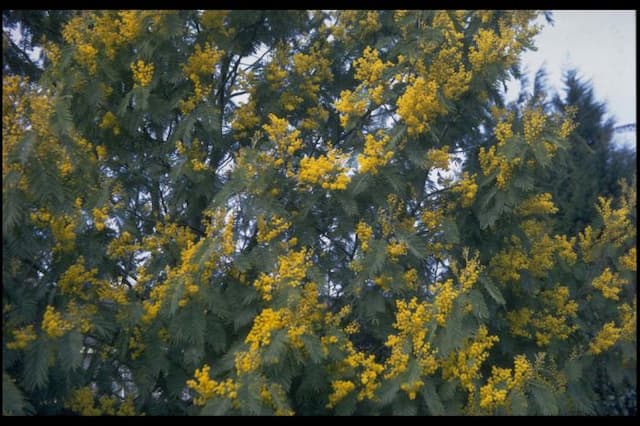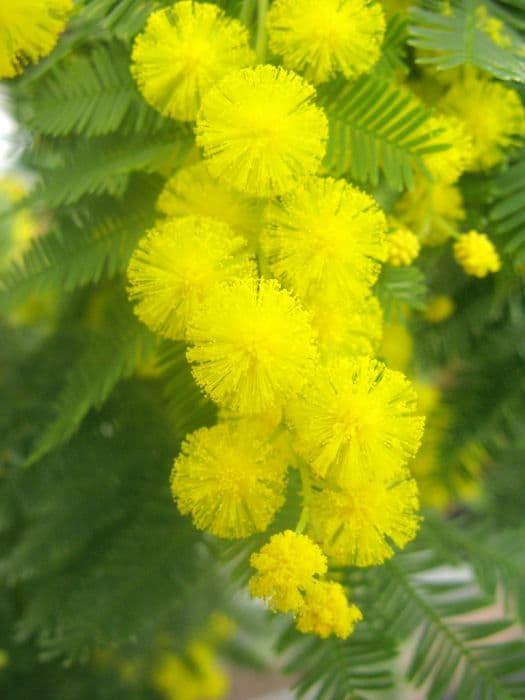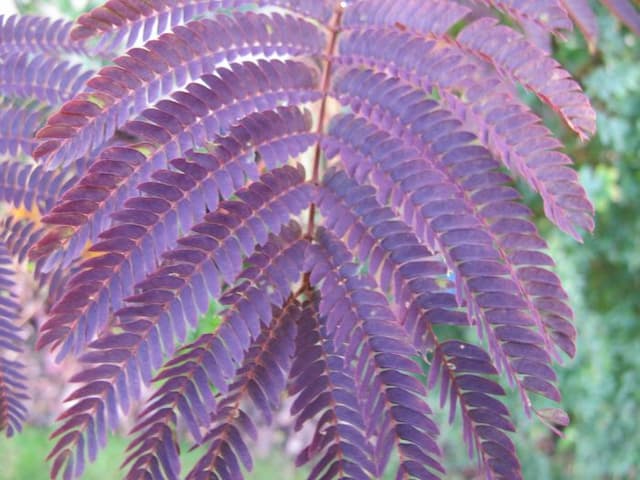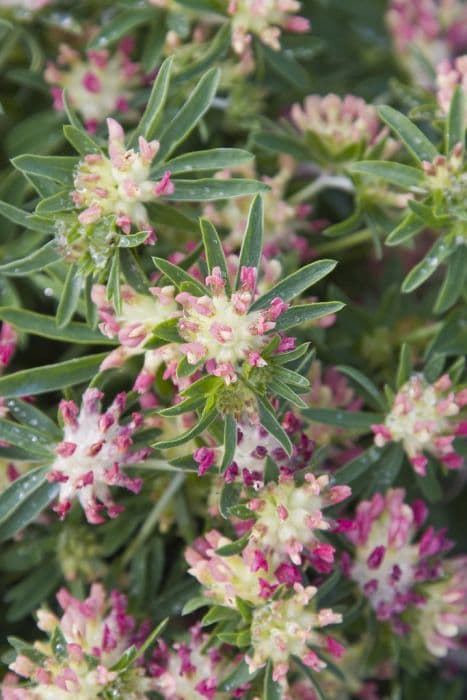Canary Island Broom Genista canariensis

ABOUT
The Canary Island broom is a lush, ornamental plant that exudes a vibrant character through its bright green foliage. Its leaves are small, needle-like, and grow densely along its stems, creating a feathery appearance reminiscent of soft brushes. The plant bursts into a vivid display of color when it blooms; its flowers are a rich yellow hue, arranged in profuse conical clusters that stand out against the verdant backdrop of the foliage. These blossoms not only add a splash of cheerfulness to the plant's aesthetic but also attract various pollinators with their sweet fragrance. The Canary Island broom's branches are somewhat wiry, and they form an intricate, spreading pattern that contributes to the plant's overall graceful silhouette. Despite the exclusion of specific size characteristics, it's worth noting that the plant possesses a well-proportioned shape, making it a captivating addition to any garden setting where it can bask in plenty of sunlight.
About this plant
 Names
NamesFamily
Fabaceae
Synonyms
Canary Island Broom, Canary Broom
Common names
Genista canariensisIA системы
 Toxicity
ToxicityTo humans
Canary Island broom is known to contain toxic compounds that can be harmful if ingested. The plant contains quinolizidine alkaloids, which can negatively affect the central nervous system. Symptoms of poisoning may include nausea, vomiting, diarrhea, abdominal pain, trembling, confusion, and potentially convulsions if ingested in large quantities. It is important to seek immediate medical attention if ingestion occurs or if any symptoms of poisoning are observed.
To pets
Canary Island broom is also toxic to pets due to its content of quinolizidine alkaloids. If pets consume any part of this plant, they might exhibit symptoms including vomiting, diarrhea, lethargy, incoordination, and difficulty breathing. In severe cases, ingestion can lead to convulsions and potentially be fatal. It is critical to consult a veterinarian immediately if your pet has ingested any part of this plant or is displaying symptoms of poisoning.
 Characteristics
CharacteristicsLife cycle
Perennials
Foliage type
Evergreen
Color of leaves
Green
Flower color
Yellow
Height
5 feet (1.52 meters)
Spread
8 feet (2.44 meters)
Plant type
Shrub
Hardiness zones
8
Native area
Canary Islands
Benefits
 General Benefits
General Benefits- Landscape Ornamentation - Genista canariensis, commonly known as Canary Island broom, adds vibrant color and unique structure to gardens with its bright yellow flowers.
- Erosion Control - The plant's dense growth habit helps stabilize soil and prevent erosion, making it suitable for sloping landscapes.
- Wildlife Attraction - Canary Island broom provides a source of nectar for bees and other pollinating insects, thereby supporting local ecosystems.
- Drought Resistance - This species is drought-tolerant once established, making it ideal for xeriscaping and water-efficient gardens.
- Low Maintenance - It requires minimal care, with occasional pruning and watering, suited for gardeners of all levels.
- Habitat Restoration - Genista canariensis can be used in habitat restoration projects, particularly in its native regions, to restore natural landscapes.
- Fast Growth - The plant grows quickly, offering rapid coverage and gratification in landscaping projects.
 Medical Properties
Medical Properties- Diuretic: Genista canariensis is traditionally used to stimulate the production of urine, assisting in the cleansing of the urinary tract.
- Laxative: It may also be used to relieve constipation, promoting bowel movements.
- Emmenagogue: The plant has been used to promote menstrual flow.
 Air-purifying Qualities
Air-purifying QualitiesThis plant is not specifically known for air purifying qualities.
 Other Uses
Other Uses- Genista canariensis, commonly known as Canary Island broom, can be used as an ornamental plant in gardens due to its attractive yellow flowers and evergreen foliage.
- The dense and bushy growth habit of Canary Island broom makes it suitable for use as hedging or for creating privacy screens in landscaping.
- Dried branches of Canary Island broom may be utilized in floral arrangements and wreaths for their unique texture and form.
- This plant's wood, being somewhat hard and durable, has been used historically to make small craft items and utensils.
- Because of its nitrogen-fixing properties, Canary Island broom can be grown to improve soil quality as a pioneer species in degraded soils or reforestation projects.
- In some regions, the Canary Island broom is cultivated for erosion control, particularly on slopes and banks that are prone to soil loss.
- The fibrous material from the plant has been used traditionally for weaving small baskets and other artisanal crafts.
- Canary Island broom may also play a role as a living windbreak, protecting more delicate plants in a garden or agricultural setting.
- The fragrant blossoms of the Canary Island broom have been used to impart a pleasant aroma in linen closets and drawers when dried and placed in sachets.
- As an ornamental topiary, skilled gardeners can shape Canary Island broom into various forms for decorative purposes in formal gardens.
Interesting Facts
 Feng Shui
Feng ShuiCanary broom is not used in Feng Shui practice.
 Zodiac Sign Compitability
Zodiac Sign CompitabilityCanary broom is not used in astrology practice.
 Plant Symbolism
Plant Symbolism- Endurance and Resilience: Genista canariensis, commonly known as the Canary Island Broom or Cytisus canariensis, often grows in challenging conditions, symbolising the ability to withstand adversity and recover from hardship.
- New Beginnings: The plant's capacity to regenerate after being burned or cut back signifies new beginnings and rejuvenation, often representing the cyclical nature of life and hope for fresh starts.
- Cleansing: Historically, brooms like the Canary Island Broom were associated with sweeping away the old to welcome the new, symbolizing purification and the removal of negativity from one’s life.
- Protection: Due to its dense growth, it can also be a symbol of protection, offering a safe shelter and a haven for various species, signifying the importance of creating a secure environment.
 Water
WaterThe Canary Island broom should be watered thoroughly, allowing the soil to become somewhat dry between waterings. During the active growth period in spring and summer, you should water it approximately once a week with about two gallons of water, depending on the size of the plant and the environmental conditions. In the fall and winter months, reduce the frequency to every two to three weeks, using around one gallon per watering session, as the plant enters a dormant phase and requires less moisture.
 Light
LightThe Canary Island broom thrives in full sun conditions and should be placed in a spot where it can receive at least six hours of direct sunlight per day. Ensuring it gets ample light will help maintain its vibrant yellow bloom and lush foliage. Avoid shady locations to prevent leggy growth and a decrease in flower production.
 Temperature
TemperatureThe Canary Island broom prefers a mild to warm climate, tolerating a temperature range from about 50°F to around 70°F. It can endure occasional dips to 40°F but should be protected from frost. The ideal temperature range for promoting healthy growth and flowering is between 60°F and 70°F.
 Pruning
PruningPruning the Canary Island broom is essential to maintain its shape, encourage branching, and promote more prolific blooming. Perform pruning after flowering ends to remove dead flowers and any overly long or dead branches. An annual pruning in late winter or early spring is typically sufficient for keeping the plant healthy and well-groomed.
 Cleaning
CleaningAs needed
 Soil
SoilCanary Island Broom prefers well-drained soil with a slightly acidic to neutral pH of 6.0 to 7.0. The best soil mix can be made with equal parts of loam, sand or perlite, and peat or compost to ensure proper drainage and fertility.
 Repotting
RepottingCanary Island Broom should be repotted every two to three years or when it becomes root-bound. Typically, young plants need more frequent repotting, while established plants can be repotted less often.
 Humidity & Misting
Humidity & MistingCanary Island Broom thrives in moderate humidity levels but is quite tolerant of lower humidity conditions typical of Mediterranean climates. It does not require high humidity to grow well.
 Suitable locations
Suitable locationsIndoor
Ensure well-lit spot, well-draining soil mix, and moderate watering.
Outdoor
Full sun, well-draining soil, protect from severe frosts if necessary.
Hardiness zone
8-10 USDA
 Life cycle
Life cycleGenista canariensis, commonly known as Canary Island broom, begins its life cycle when the seeds germinate, typically in a well-draining and sunny environment. After germination, the seedling stage involves the development of a deep taproot and the establishment of primary leaves. As it enters the vegetative stage, the plant grows rapidly, forming a bushy structure with trifoliate leaves and woody stems. The reproductive stage follows, usually in the spring, when Canary Island broom produces abundant yellow pea-like flowers that are pollinated by insects. Following pollination, the flowers develop into pods containing seeds that mature and eventually burst open to disperse seeds for the next generation. Canary Island broom is a perennial plant, so this cycle of growth, flowering, and seed dispersal can happen annually for many years, depending on environmental conditions and proper care.
 Propogation
PropogationPropogation time
Spring to early summer
Propogation: The Canary Island broom (Genista canariensis) is primarily propagated through seed sowing. The optimal time for sowing seeds is in the spring after the last frost has passed, ensuring a conducive environment for germination. To propagate the Canary Island broom from seeds, one should first soak the seeds in warm water for 24 hours to soften the hard seed coat, which enhances germination rates. Following the soaking period, seeds are sown in a well-draining soil mix, lightly covered with soil, and kept moist until germination occurs. Seedlings require ample sunlight and should be protected from extreme temperatures; once established, they can be transplanted outdoors to their final growing positions. This method emphasizes the plant's natural growth cycle and offers a straightforward approach to propagation for gardeners looking to increase their collection of this vibrant and hardy shrub.









